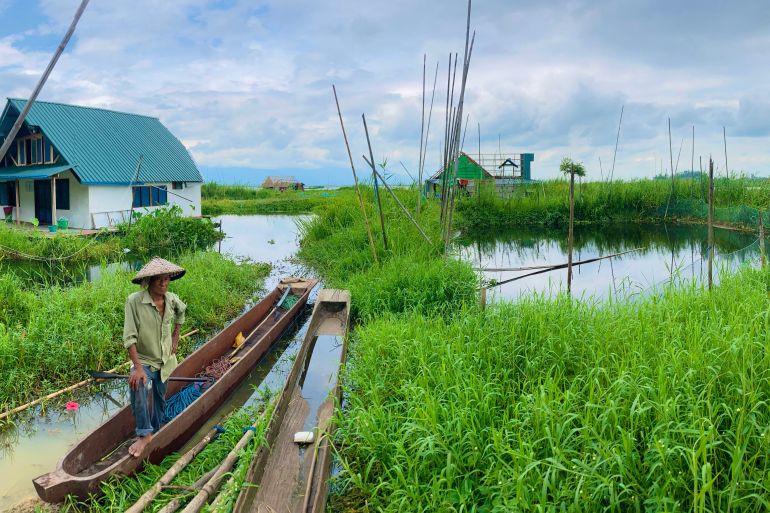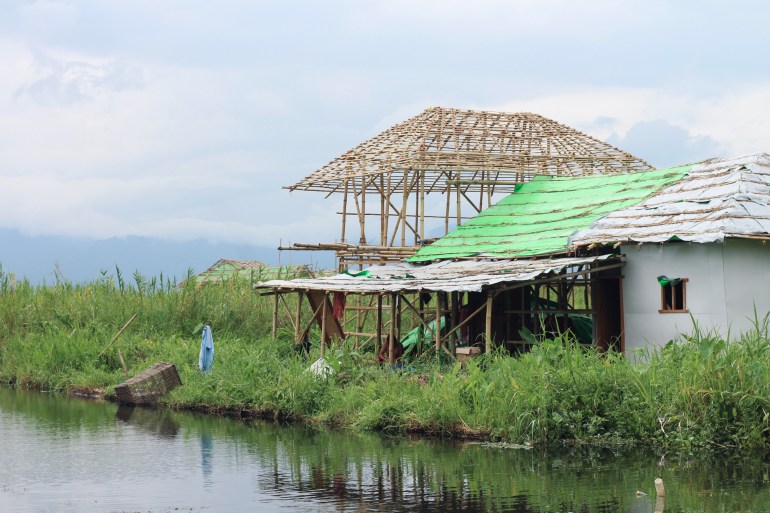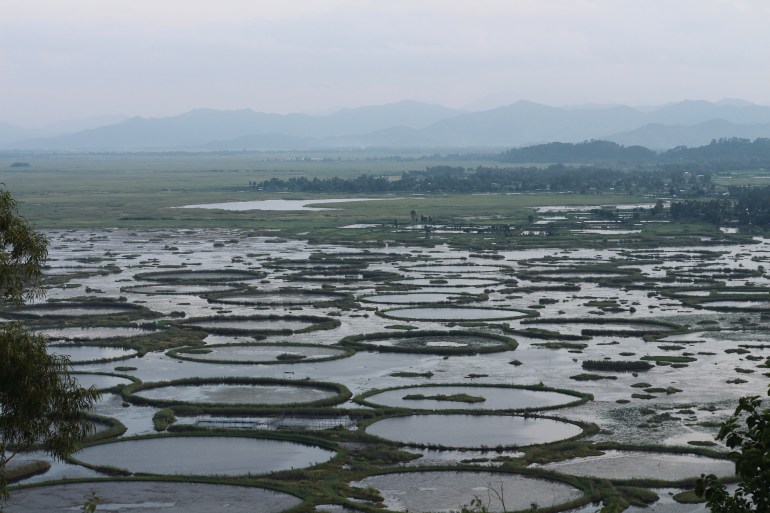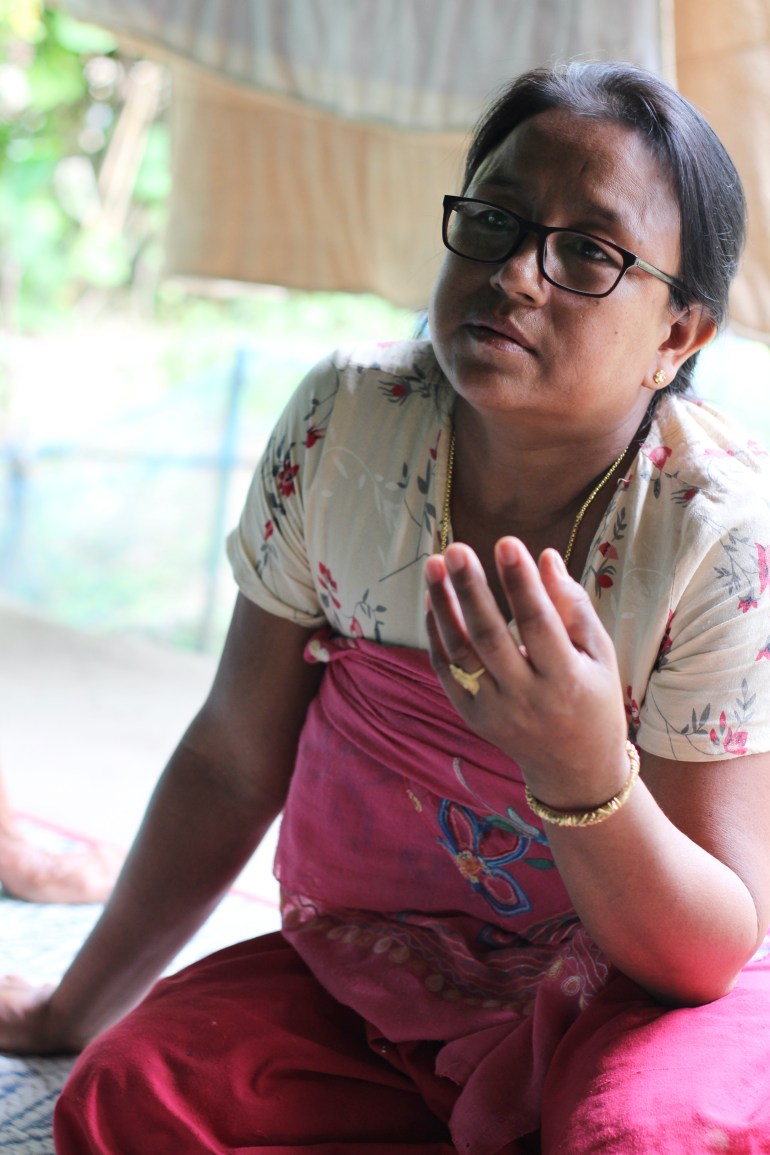Future adrift: India’s Indigenous Meitei lose floating homestays
Manipur state has chosen multimillion-dollar projects over humble tourist attractions on the Loktak freshwater lake.

Bishnupur, India – There are ripples of unrest on Loktak, one of India’s largest freshwater lakes, where the state government ordered the destruction of the Indigenous people’s tranquil homestays which were encouraged to thrive as a draw for tourists.
The government in the once-restive state of Manipur in northeastern India instead has plans for large multimillion-dollar projects on the 287-square-kilometre (110-square-mile) lake, which is a biodiversity hotspot and home to the Meitei community.
Keep reading
list of 3 itemsIndian Manipur separatists announce exiled government in UK
Droupadi Murmu takes oath as India’s first tribal president
To the people who have lived on and off Loktak, the lake is more than a source of their livelihoods. It is a deity, called Loktak Lairembi, revered as a mother, central to the Meitei belief system.
Listed as a “wetland of international importance” under the 1971 Ramsar Convention, a global treaty on the conservation and sustainable use of wetlands, Loktak is home to hundreds of varieties of fish, molluscs, aquatic plants, migratory birds and the rare Sangai deer.
Since 2013, it became a key income stream for the Meitei, many of who built floating homes on the thick vegetation characteristic of Loktak, which they opened up to visitors for a unique experience.
Government about-face
Ramsar urges all 172 signatories, which includes India, to ensure the participation of local communities in managing wetlands.
But in July, the Loktak Development Authority (LDA) cited the same convention when it ordered the demolition of the homestays in the name of protecting biodiversity, with little proof that they were causing harm.

On the island village of Thanga on Loktak, Leishi (name changed on request) despondently watched her husband dismantle the floating homestay they built with their savings and ran for four years.
The state agency had once encouraged the endeavours of Leishi’s family and dozens of others to run the homestays, which thrived for nearly a decade. All 41 homestays have now been demolished by their owners who were compelled to destroy their main source of income or face eviction.
Lives upended thrice
This is not the first time that the government has upended the lives of people from Loktak.
In 1983, the state built the Ithai barrage on the Manipur river, which feeds into the lake, forever changing its ecological patterns by choking the freshwater flowing in.
Before the barrage was built, residents owned fields and would also fish for part of the year. They engaged in the traditional “ataphum” fishing, in which the fish are trapped in circular enclosures created by “phumdis” or floating vegetation.

The lake’s water levels would rise and fall with the changing seasons. When they dropped, grazing cattle would break up the “phumdis”, for which the lake is famous, and prevent their proliferation.
But the barrage submerged 60,000 hectares (150,000 acres) of agricultural fields. The community had little choice but to start practising “ataphum” year-round, which led to overfishing.
“We used to have fertile agricultural fields. We cultivated rich, organic produce and never fell short of anything. But the Ithai barrage submerged all of them. That’s why I ran the homestay because I still need to feed my family,” said Oinam Maipakchao Singh.
In 2011, the LDA burned down homes in Loktak’s “core” or protected zone.
New source of revenue
The homestays were not only an alternative to hotels but also a new source of revenue for those whose livelihoods were literally sunk by the barrage.
The community-led initiative offered tourists a unique experience of staying on a floating island of vegetation. They existed with encouragement from the government, and also hosted top administration officials.
They didn’t come cheap. A typical homestay required an initial investment of about $10,000. While they were open year-round, they brought in roughly $400 a month during the peak tourist season in June and July.
The average annual household income in Loktak ranges between $914 and $5,375, according to a Loktak management plan commissioned by the Manipur government.
Most owners got the seed money by borrowing from family, or moneylenders. Leishi said her family spent 1.2 million Indian rupees ($14,500) on building their homestay.
As they mushroomed, the owners established the private Loktak Floating Homestay Association, Thanga, in May 2022 on the insistence of the LDA, they claimed.
No option to negotiate
The residents of Loktak, fisherfolk and homestay owners held a protest after receiving the LDA’s eviction notices.
Days later, the agency urged the homestay owners to sign an agreement, promising to give “priority, in the event of issuing permits in the future, to those homestay owners who dismantle the structures voluntarily”.
There was never a question of the floating huts becoming authorised structures, as the LDA had promised, unless the state government amended the law.
The Manipur Loktak Lake (Protection) Act, 2006 classifies all constructions in the core zone of the lake as encroachments.
The homestay owners maintain the LDA had promised to issue sample designs and regulations before the annual Sangai tourism festival in November to ensure the homestays were both sustainable and authorised.
But they say the agency was merely trying to appease local communities while formally destroying their livelihoods.
“The verbal promise made to us by the LDA, to provide us with regulations, does not even feature in the [agreement] we were asked to sign,” said S Hemanta Soren, vice president of the association. “They prepared it themselves and asked us to sign it. There was no option to negotiate.”
Salam Memshaleima, whose family ran a homestay, said: “We borrowed money for our business at 7 percent interest. Not only did we spend money constructing the homestay, we are now spending on labour to dismantle it.”

The state has not offered any compensation, resettlement or rehabilitation to the homestay owners.
Neither has the government formally notified the lake under the wetland rules, which would have required it to acknowledge the existing livelihood rights of the people.
“The recognition of pre-existing rights and privileges through notification of a wetland would prevent an authority such as the LDA unilaterally taking them away,” explained Malvika Kaushik, an environmental lawyer and researcher.
No scientific assessment
The LDA said its goal was to remove Loktak from the Montreux Record – a list of Ramsar sites whose ecological character has degraded.
Loktak was added to the record in 1993 because of problems such as siltation caused by deforestation, a proliferation of water hyacinth and pollution.
Inclusion in the record is voluntary, and does not carry any sanctions against a government.
Could the homestays have been altered to become a route to sustainable livelihoods, or were they so damaging to the ecology of the lake that they had to be dismantled?
“The LDA did not undertake any scientific assessment to be able to say that it was the homestays responsible for the deterioration of the lake, before issuing the notification,” said Ram Wangkheirakpam, founder of the non-profit Indigenous Perspectives.
An integrated management plan prepared by Wetlands International South Asia (WISA), a non-government body, in collaboration with the LDA in 2020 noted far more serious concerns.
Significantly, one of the factors was the decline of the interface with local communities on wetlands management.
Another state agency agreed. “We have time and again directed the LDA to ensure it conducts impact assessments before it takes any action on Loktak, but it has never done so,” said T Brajakumar, joint director of the Manipur State Wetlands Authority (MSWA).
In August, the homestay owners appealed to the MSWA to intervene against the LDA’s demolition orders, but it did not.
“We are just the governing body responsible for implementation of the Wetlands Rules, 2017 [federal government rules], not the implementing agency for actions taken on Loktak,” said Brajakumar.
Local communities sidelined
The people most affected by changes on and around Loktak were never part of any of the government’s plans for the lake.
“At the very least, we should be informed so that we can decide whether or not we support these projects. How can the government, responsible for public welfare, behave like a dictatorship?” asked Oinam Rajen, secretary of the All Loktak Lake Area Fishermen’s Union (ALLAFUM).
Reports of a proposed mega-ecotourism project on Loktak have been floating around for years, and India’s ruling Bharatiya Janata Party (BJP) included it in its manifesto for its 2022 re-election campaign.
“The LDA sees Loktak as a gold mine,” said Salam Rajesh, a journalist and conservationist. “There is a lot of money in conservation, so the authorities are least bothered about its impact on the community.”
For the people living in the floating village of Thanga, their future has now been cast adrift. And what if the LDA does not make good on its promise to issue designs and regulations to allow homestays to function in an authorised manner?
“This was the first time, so we have compromised. But next time, we will agitate,” said Hemanta. “We have a hand-to-mouth existence. What other choice do we have?”